In 1927, it was nothing short of a mission impossible: around 22,000 km from London to Sydney, few roads and sparse refuelling options. But even a brush with death after a bout of Malaria couldn’t stop Aussie adventurer and explorer Francis Birtles, who had over 70 transcontinental crossings under his belt, from completing the perilous odyssey in his Bean Torpedo sportscar nicknamed the ‘Sundowner’. The impressive feat, which took him through mountains, deserts, tropical jungles and sea, took about nine months. In Burma, Birtles’ team had to chop trees to make way for the car!
Almost a century later, septuagenarian couple Lang and Bev Kidby took on the challenge of replicating Birtles’ epic journey, which very few people have dared to embark on. After all, it was Lang’s dream to follow in the footsteps of his family idol ever since he was a boy. And his wife, Bev, shares his passion for adventure. Over the past 40 years, the duo has participated in various expeditions, some of which were led or organised by them, and covered over 80 countries.
The couple had completed two-thirds of their UK-to-Australia road trip by the time they arrived in India via the Wagah border on May 30.
Autocar India met the Kidby at the sprawling Cossimbazar Palace of the Roys, located near the Berhampore subdivision of Murshidabad, where they spent a few days before heading to Kolkata. This was the couple’s ninth visit to the country.
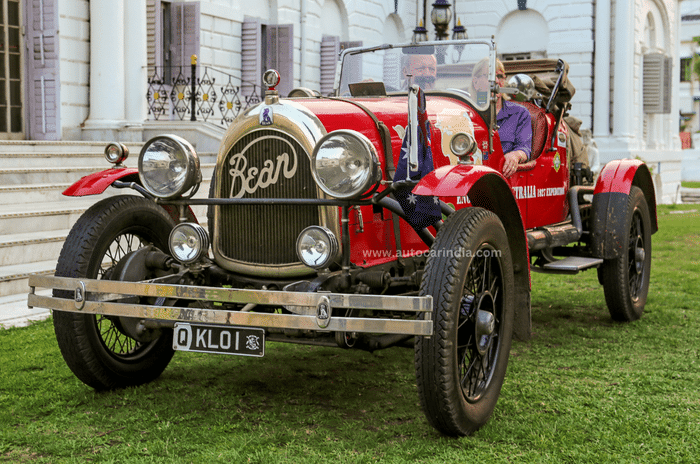
A way of life
Despite enduring a couple of hours of driving in the unbearable heat in their 1923 Bean 14 car, 77-year-old former army pilot Lang and Bev (78) appeared quite chilled out.
“Over 55 years of marriage, we’ve trudged through some pretty awesome places and met some interesting people along the way,” said Bev, who looks after the administration and handles other behind-the-scenes work such as logistics and updating their website and blogs. Traversing the world has been their “way of life for many years”.
As for Lang, adventure runs in his family.
“Way back in 1936, Birtles was at the height of his fame, and my dad Richard, as a 16-year-old, and his 14-year-old brother, inspired by their hero, undertook a 3,000km journey on their bikes from Melbourne to Home Hill [near Townsville] in Queensland. It was a dirt road all the way and it remains one of the greatest teenage rides to this day,” shared Lang, whose father entered the car business after returning from World War II.
Naturally, Lang was deeply inspired by Birtles. So, he embarked on the journey to find a Bean to repeat his hero’s 1927 expedition.
Bean there, doing that
Things got set into motion in 2023 when Lang found that a 1923 Bean car was displayed at Gilbert’s Motor Museum in Strathalbyn, South Australia .The car was being advertised as part of the estate of a renowned collector, the late David Read.
Lang wasted no time and called the family. “We talked and talked. They said their dad [David Read] dreamt of doing this trip but never did.”Finally, the car was sold to Lang on the condition that he would embark on that trip.
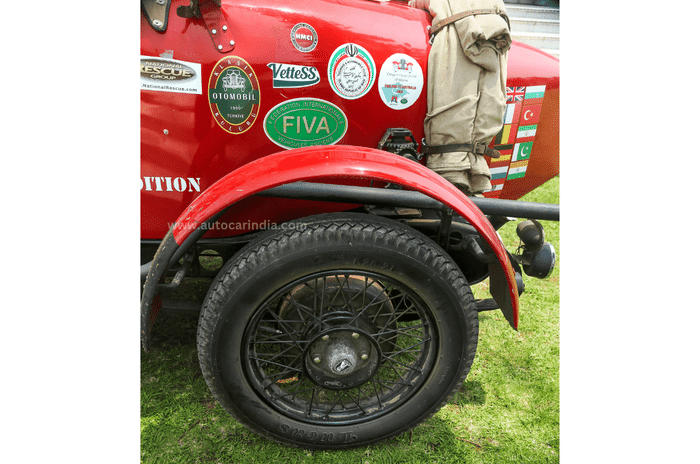
“So, I got the car. We didn’t rebuild it or anything like that. A few improvements were made in the electricals, wherein an extra belt-driven alternator and an electronic overdrive kit were affixed to the propeller shaft. For safety reasons, extra lights were fitted up front and rear.
The car’s cockpit was cramped for Lang, who had to modify the steering wheel arrangement; it is removable, just like a modern F1 car’s, making it easier for him to egress or ingress. A few centimetres of the leather passenger seat were shaved off to accommodate Bev and allow Lang to drive the car without bumping into her.
Bean cars rivalled Morris, Austins and Vauxhalls
Beans were originally manufactured in the UK by A Harper Sons & Bean, which is defunct now. They were considered to be better built than Austin and Morris cars and rivalled Vauxhall vehicles.
Carmaker Standard-Triumph took over Bean in 1956, and it became part of Leyland Motors in 1960. In the 1980s, the then Prime Minister of the UK, Margaret Thatcher, broke up British Leyland. In 1988, Bean was bought by its management team, which hoped to revive it, but that hasn’t happened.
Beans are now highly collectable due to their rarity. The brand also had a dealership called Barlow Motors in Australia. To promote Bean cars locally in the early 20th century, this enthusiastic dealer used to organise long-distance endurance drives with ardent drivers and adventurers.
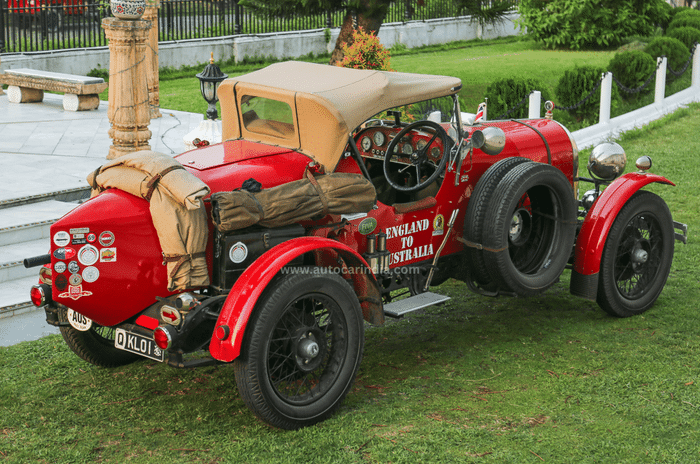
14 model: Kidbys’ Bean
Bean introduced the 14 model in 1923. It was powered by a unitary constructed 2,380cc 4-cylinder side-valve engine mated to a 4-speed gearbox. The long-stroke engine produced a modest 32hp at 2,400rpm, which limited top speed to 50mph (80kph). The 14 was robust and earned respect as the most classic in the Bean model line-up.
The exhaust port head design is unique as only three pipes come out and merge into one. The exhaust setup is external along the left side of the car, above the small runner board. The ignition system is unusual as it has more than one mechanism: a magneto with a distributor and a conventional coil with a separate distributor. The H/T coil gets its power from the battery. It can also be cranked manually. There are dedicated switches on the dashboard to operate the various ignition combos. A toolbox, a jack and an original Dead Ezi tyre pump have been mounted on the car.
As with period cars, there’s a lot of wood in the structure. The lacquered, ash wood dashboard is quite a busy area with an array of instruments such as an altimeter, a speedometer, a rev counter, and an oil-level indicator made by Smiths.
A mechanical fuel gauge is fitted on the fuel tank mounted on the rear chassis. The steering wheel hosts the advance/retard and throttle control levers. The gear shifter is original, and Lang has installed an emergency power cut-off switch on the wooden floorboard. Lang has added an extra alternator to boost battery charging as the 15-amp dynamo was found to be insufficient.
The car’s clutch is unassisted and quite hard to operate and a gear change requires a double declutch. The throttle pedal sits in the middle of the clutch and the brake pedal is underneath the steering column. The turn radius isn’t so good. The ground clearance is quite high, partly due to the large 525/21-inch balloon tubed tyres and spoke wheel combo.
The Bean’s huge and unusually wide brake drums accommodate two sets of pads. Both are mechanically activated via linkages, like in motorcycles, with one set acting as the main stopper and the second one as a handbrake. For short stopping distances, Lang operates both of them together.
Body and soul
All Bean 14 models had four-door, family-car body styles, and most of them disappeared, said Lang.
However, Lang’s 14 model has been rebodied and patterned after the Birtles’ Sundowner, which is a 2-seater torpedo-shaped sports car. This rebuilding was done by David Ragless, a Bean enthusiast and collector from South Australia, in the 1970s to feature the car in the 1988 Bicentennial National Rally for a drive from Adelaide to Canberra.
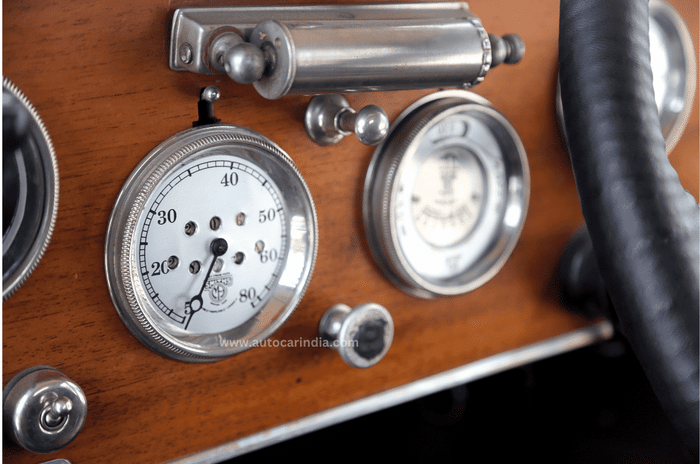
For the rebuild, Ragless unbolted the body from the chassis and engaged highly skilled metalworkers to handcraft the car in aluminium within a 2mm tolerance as compared with the original. The restoration project came with mostly stock mechanicals, and several Bean owners donated original parts. The unobtainable replacements were manufactured to original specifications from factory drawings, manuals, and photos.
Birtles’ original car—now displayed at the Australian National Museum in Canberra and then housed in a South Australian museum—served as a reference. It was meticulously measured with cameras and tapes; all that helped in pattern-making.
The journey
Before setting out from the UK in mid-April in their Bean 14 with a fabric soft top, the couple did a recce of the proposed route and traversed through several countries in Europe, Turkey, Iran and Pakistan. “That’s about 12,000 kilometres,” said Lang.
The car has two fuel tanks that take in 50 litres each, so frequent refuelling hasn’t been an issue. Depending on terrain, “you can run the two ignition systems (magneto and coil) together; if you’re going uphill, it helps,” said Lang.
The 96kph top speed couldn’t be improved as the electronic overdrive malfunctioned. “Sadly, it didn’t work as planned,” lamented Lang.
The trip had been mostly smooth, barring a few snags such as a magneto failure, a cracked distributor cap and a fault in the starter motor. Lang said the car had to be hand-cranked for a few days before some enterprising mechanics in Iran and Pakistan modified the faulty and broken parts, like the starter motor.
Since the engine cooling system is old-school, it requires frequent topping up. “On a really hot day, you might have to top it up [with water] a couple of times. Each morning, I would top up, and that seemed to be enough to get us through,” he explained. “Normally, the radiator performance is very good when air passes through it, but just crawling in the traffic with no wind coming through and the very high temperatures can [have an] impact. It has boiled a couple of times.”
Recalling the drive in Pakistan, Lang shared that the Bean and the escort cars broke down due to intense heat. “It was the highest temperature recorded on the day, around 55° Celsius. That’s the highest ever recorded in the world after Libya in 1913.” And of course the car has no air conditioning.
The India chapter
The Kidbys’ travel was planned by the International Federation of Historic Vehicles (FIVA). For the India chapter, FIVA partnered with the Heritage Motoring Club of India (HMCI) and the Classic Drivers Club (CDC) in Kolkata.
After crossing the border on May 30, the Bean team was welcomed and escorted to Amritsar. From there, they proceeded to Chandigarh and New Delhi. Sadly, Bev couldn’t drive with Lang from Lahore to India due to visa restrictions. So, she flew from Pakistan to Dubai and then caught a flight to New Delhi, where she was reunited with Lang and the Bean.
In New Delhi, where the Kidbys stayed for two days,the Bean was thoroughly cleaned, and several repairs were made. Then, the team proceeded to Agra, Lucknow, and Varanasi. The HMCI made all the arrangements for Lang’s stay in all these cities and even organised receptions and press interactions.
After Varanasi, the next destination was Gaya. Once the team entered West Bengal, it was the CDC’s turn to look after them and the Bean. The CDC is the only FIVA member club in India at this point.
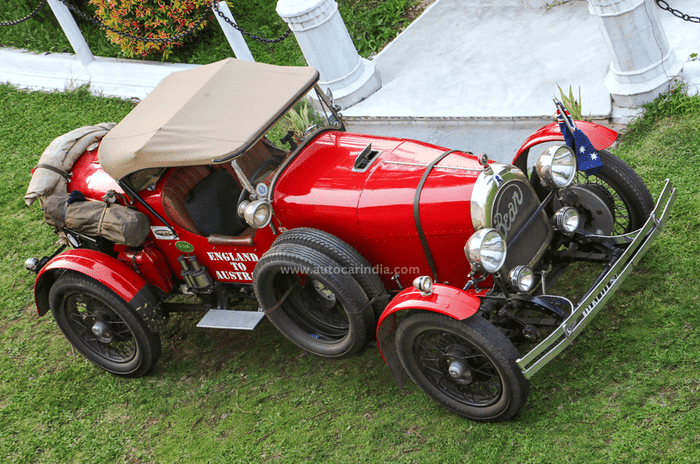
On June 7, eagerly awaiting the Kidbys, an advance party of CDC members left Kolkata early in the morning for Durgapur. The Kidbys spent the day recovering from the extreme heat and rudimentary weather protection available in the Bean.
The following morning, the Bean team left for a CDC member’s historic palace, the Cossimbazar Palace of the Roys, to enjoy their hospitality. The estate’s owners had arranged for a traditional Indian welcome, and the Kidbys were whisked away into the massive, cool reception halls. In the evening, a cultural programme involving music, dance and theatre, organised for the couple and the CDC members, livened up one of the old palace courtyards.
Unsurprisingly, the Kidbys stayed back for another day while the club members left for Kolkata. On June 10, the Bean and the Kidbys made their way to Kolkata to spend the week.
The onward drive from India to Myanmar had to be cancelled as the country has for now closed its borders. The Kidbys were planning to ship the car to either Malaysia or Singapore before completing the last leg of the trip.
Bon voyage
The couple’s passion for travel and their dedication to preserving and showcasing the historical significance of the Bean car is commendable. It’s fascinating how they’ve encountered challenges along the way, from mechanical issues to navigating through extreme weather conditions. Yet, they persevere with determination and adaptability.





























